Attachment 7 Screen shots
National Tobacco Control Program Chronicle Progress Reporting System
Attachment 7 Screen shots
National Tobacco Control Program Chronicle Progress Reporting System
OMB: 0920-0601
Submission for Revision of
Federally Sponsored Collection of Information
The National Tobacco Control Program (NTCP)
Chronicle Progress Reporting System
OCSO revisions 12/21/06
Paul Hunting, MPH
Centers for Disease Control and Prevention (CDC)
National Center for Chronic Disease Prevention and Health Promotion (NCCDPHP)
Office on Smoking and Health (OSH)
Table of Contents
Item |
Page |
Paper Work Reduction Act Form OMB 83-I |
|
Privacy Act Checklist |
|
Privacy Act Narrative |
1 |
30-Day Federal Register Notice |
2 |
A. Justification |
|
1. Circumstances Making the Collection of Information Necessary) |
7 |
2. Purpose and Use of the Information Collection |
8 |
3. Use of Improved Information Technology and Burden Reduction |
9 |
4. Efforts to Identify Duplication and Use of Similar Information |
10 |
5. Impact on Small Businesses or Other Small Entities |
11 |
6. Consequences of Collecting the Information Less Frequently |
11 |
7. Special Circumstances Relating to the Guidelines of 5 CFR 1320.5 |
11 |
8. Comments in Response to the Federal Register Notice and Efforts to Consult Outside the Agency |
11 |
9. Explanation of Any Payment of Gift to Respondents |
13 |
10. Assurance of Confidentiality Provided to Respondents |
13 |
11. Justification for Sensitive Questions |
13 |
12. Estimates of Annualized Burden Hours or Costs |
14 |
13. Estimates of Other Total Annual Cost Burden to Respondents and Record Keepers |
15 |
14. Annualized Cost to the Federal Government |
15 |
15. Explanation of Program Changes or Adjustments |
15 |
16. Plans for Tabulation and Publication and Project Time Schedule |
16 |
17. Reason(s) Display of OMB Expiration Date in Inappropriate |
17 |
18. Exceptions to Certification for Paperwork Reduction Act Submissions |
17 |
B. Statistical Methods |
|
1. Respondent Universe and Sampling Methods |
17 |
2. Procedures for the Collection of Information |
17 |
3. Methods to Maximize Response Rates and Deal with Non-response |
17 |
4. Test of Procedures or Methods to be Undertaken |
18 |
5. Individuals Consulted on Statistical Aspects and Individuals Collecting and/or Analyzing Data |
18 |
List of Attachments |
19 |
Attachment 1 – Authorizing Legislation |
20 |
Attachment 2 – 60 Day Federal Register Notice |
25 |
Attachment 3 – Instructions to Respondents for Completing Information Collection |
28 |
Attachment 4 – NTCP Chronicle External Users Feedback and Persons Involved |
29 |
Attachment 5 – NTCP Chronicle Online Training External Users Pilot Testing and Evaluation |
32 |
Attachment 6 – Original Data Systems Elements |
35 |
Attachment 7 – Revised System Data Elements and Related Screen Shots |
44 |
ATTACHMENT 7
REVISED SYSTEM DATA ELEMENTS AND SCREEN SHOTS
The specific changes to the NTCP Chronicle are interlaced throughout the system and are difficult to specify in every instance. The changes are proposed to more accurately reflect the activities and accomplishments of the Cooperative Agreement recipients as specified in the original Program Announcement; to reduce needless duplication of information submitted in Progress Reports; enhance the ability of recipients to accurately reflect the full body of their work; and to more accurately reflect the time burden relating to planning and reporting within the NTCP Chronicle.
No new data is being collected as a result of this proposed revision.
Methodological Approach
The NTCP Chronicle is a program monitoring system that allows for states to input their program’s annual action plan, consisting of outcome and process (output and infrastructure) objectives, and goal- and infrastructure-related activities; they can then modify their plan and describe progress over time. A state’s annual action plan will in general contain objectives and activities addressing each of the following 11 performance measures:
NTCP Goal: Prevent the initiation of tobacco use among young people
NTCP Goal: Promote quitting among young people and adults
NTCP Goal: Eliminate exposure to secondhand smoke
NTCP Goal: Identify and eliminate the disparities related to tobacco use and its effects among different population groups
Infrastructure: Collaboration with Partners
Infrastructure: Communication & Information Exchange
Infrastructure: Local Grants Program
Infrastructure: Program Management
Infrastructure: Strategic Planning
Infrastructure: Surveillance & Evaluation
Infrastructure: Training & Technical Assistance
The main components of a state’s plan include: A) outcome objectives, B) process (output and infrastructure) objectives, C) goal and infrastructure activities, and D) policy focus statements. Within the Chronicle states describe their annual action plan by inputting information about each of these components. There are no limits to the number of objectives or activities a state can submit as part of their annual action plan.
SCREEN SHOTS: Annual Action Plan Elements
(Screen shot # 1) - Creating an Outcome Objective
Outcome Indicators: states first provide information on their outcome indicators. Indicators are chosen from a list of key indicators developed by OSH and published in Key Outcome Indicators for Evaluating Comprehensive Tobacco Control Programs- May 2005 (Atlanta, GA, HHS). Outcome indicators are specific to one of three program goals and are separated into long-term, intermediate term and short-term indicators that assist states in indicating the science-based pathway to achieving distal outcomes of reduced morbidity and mortality related to tobacco use. Note that by definition each outcome indicator is both goal and term specific.
Once the state has provided an indicator for their outcome objective, for each outcome objective they create they provide:
Data source and data collection details: states choose their data source from a drop down list and provide data collection details if necessary.
Objective statement: States provide a description (statement) of their outcome objective. They are requested to make it SMART (specific, measurable, achievable, relevant and time bound).
Target population (drop down list) and if necessary, target population details
Measurement, baseline and target
Baseline and target measurement timeframe (month and year)
If baseline is unavailable, the state is asked to address plans for collecting baseline data
(Screen shot #2) - Outcome Objective Status Observation
For each objective created, twice a year a state is asked to provide information on the status of that objective. This observation is a means of providing status on achievement of (or movement towards reaching) the objective. The observation includes:
Status category (drop down list, choose one) - Ongoing, met, unmet, or suspended.
Status Comments. This is an opportunity for the state to provide a qualitative comment on the status of their objective.
Barriers statement (required by PGO if status is reported as anything except met). This would be a statement describing any barriers encountered in achieving objective.
Proposed action statement (required by PGO). This will allow state to explain how barrier(s) will be addressed.
Current measurement and date
B. Creating a Process Objective
There are two types of process objectives, output, which are associated with NTCP goal activities and outcome objectives, and infrastructure, which are associated with infrastructure activities. They are addressed here separately as they contain slightly different data fields.
(Screen shot #3) - Creating an Output Objective
For each output (process) objective created, states provide:
Output indicator: states must create their own process-level indicators using the custom indicator tool (Screen shot #4)
Data source and data collection details, if applicable
SMART objective statement
Target population and if necessary, target population details
Measurement, baseline and target
Baseline and target measurement timeframe (month and year)
If baseline is unavailable, the state is asked to address plans for collecting baseline data
Indication of applicable linkages. An output objective can link to other output objectives or short-term objectives. These linkages are used within the Chronicle system to indicate supporting relationships between the components. For example, an output objective linked to a short-term goal-specific outcome objective indicates that the specific output from that objective is causally presumed to contribute to the short-term outcome objective it is linked to.
Indication of whether this objective is supported by federal funding.
(Screen shot #5) - Creating an Infrastructure Objective
Infrastructure indicator: states must create their own process-level indicators using the custom indicator tool (Screen shot #6)
Description of data source and data collection plans
Infrastructure objective statement
Primary and Secondary infrastructure area
Target population and if necessary, target population details
Measurement, baseline and target
Baseline and target measurement timeframe (month and year)
If baseline is unavailable, the state is asked to address plans for collecting baseline data
Indication of applicable linkages. An infrastructure objective can only link to other infrastructure objectives.
Indication of whether this objective is supported by federal funding.
(Screen shot #7) - Process Objective Status Observation
For each process objective, twice a year a state is asked to provide information on the status of that objective. This observation is a means of providing status on achievement of (or movement towards reaching) the objective. Process objective status is the same for both output and infrastructure process objectives. The observation includes:
Status category (drop down list, choose one) - Ongoing, met, unmet, or suspended.
Status Comments. This is an opportunity for the state to provide a qualitative comment on the status of their objective.
Barriers statement (required by PGO if status is reported as anything except met). This would be a statement describing any barriers encountered in achieving objective.
Proposed action statement (required by PGO). This will allow state to explain how barrier(s) will be addressed.
Current measurement and date
(Screen shot #8) - Creating an Activity
States then provide activity descriptions. Activities entered into the Chronicle are defined as events or actions that help a program meet its objectives. When states provide information about their specific activities, they must select the activity type, either NTCP Goals or Infrastructure, depending on whether the activity supports NTCP output objectives or infrastructure objectives.
For each activity created, states provide:
Activity type, either NTCP Goal or Infrastructure
Available populations and population details
Start date and target date for completion
If NTCP goal activity, state must indicate the activities applicability to one or more of the following strategy areas:
Community Intervention and Mobilization
Counter Marketing
Policy/Environment
Surveillance and Evaluation
Lead Roles, indicating both Organizations and Personnel involved in the activity
Lead Role comments, if applicable
Indication of applicable linkages. An activity of type NTCP Goals can link to multiple output objectives. An activity of type Infrastructure can link to multiple infrastructure objectives. These linkages are used within the Chronicle system to indicate supporting relationships between the components. For example, an activity X linked to an output objective A indicates that the activity support the output of that particular objective.
(Screen shot #9) - Activity Status Observation
For each activity, twice a year, a state can choose to provide information on the status of that activity. This observation is a means of providing status on completion of the activity. The observation includes:
Status category (drop down list, choose one) - Ongoing, completed or suspended.
Status Comments. This is an opportunity for the state to provide a qualitative comment on the status of their activity.
(Screen shot #10) - Creating Policy Focus statement
For each of the four NTCP goals, states provide a brief statement of the policy outcomes (including social and environmental changes) that they expect from work on that goal. (Character limit: 1000)
SCREEN SHOTS: Interim and Annual Progress Reporting Assessment Questions
As part of their twice-yearly progress report submissions, states also answer a set of questions that provide information related to their progress on the 11 Performance Measures as well as questions related to programmatic capacity building. These questions are open text fields.
(Screen shot #11) - Executive Summary and Program Narrative
Provide a brief narrative that summarizes plans to address the Program Goals for the next year, indicating major areas of future program focus. (Character limit: 1,250)
Describe changes, within the past year, in the social, political, and/or fiscal environment in which your state's program is planned, implemented, and evaluated. Include any relevant factors you expect to influence, promote, or inhibit program planning, implementation and/or evaluation. (Character limit: 7,500)
(Screen shot #12) - Major Accomplishments and Barriers
Describe 5 to 10 of your program’s most significant accomplishments during the last 6 months.
Describe barriers, unmet needs and plans to address them for infrastructure areas and NTCP goals.
(Optional) Please indicate any specific requests you may have of the Office on Smoking and Health for guidance and technical assistance during the next six to twelve months
(Screen Shots 13 and 14) - The following questions all pertain to the 11 OSH Performance Measures which are part of the current 5-year cooperative agreement. They have a character limit of 5000. Screen shots # 13 and 14 provide representative examples of how these questions are presented.
Program Management
Describe major staffing changes, including new hires and changes in roles and primary responsibilities. For each new hire, provide the name, program role, and qualifications.
Describe progress toward enhancing the skills and knowledge of state program staff.
Describe relationship with and involvement of the state health officer in tobacco control issues.
Briefly describe any components of your program that are not funded by CDC but are managed or administered by CDC-funded staff.
Describe progress toward ensuring inclusivity in planning, implementing, and evaluating all program goals, objectives and strategies.
Strategic Planning
Describe progress towards developing, implementing and updating the 5-year strategic plan to include the participation of diverse partners, and the integration of other appropriate State Health Department chronic disease strategic plans.
Describe progress toward tracking, monitoring, and reporting the health and economic burden of tobacco use, including tobacco-related disparities.
Describe progress toward developing and implementing your program evaluation plan and how diverse stakeholders are involved. Describe evaluation report content and dissemination.
Collaboration with Partners
Describe progress toward maintaining and strengthening statewide and local partnerships and coalitions including diverse partners and coalitions.
Local Grants Program
Describe progress made by local grantees and coalitions toward implementing evidence-based policy interventions that support the state program objectives.
Training
Describe efforts to identify and address training needs of state and local health department staff, coalitions, contractors, and partners.
Technical Assistance
Describe efforts to identify and address technical assistance needs of state and local health department staff, coalitions, contractors, and partners.
Communication and Information Exchange
Describe progress toward developing and implementing your stakeholder communication plan. Describe media strategies at the state and local level, including paid and earned media and media advocacy strategies.
Describe participation in and benefits gained from information exchanges with local grantees, CDC/OSH, tobacco control program personnel in other states, and national partners.
Initiation
Describe progress toward developing and implementing science-based, policy-focused strategies to prevent tobacco use among young people and strategies to eliminate tobacco-related disparities.
.
Secondhand Smoke
Describe progress toward developing and implementing science-based, policy-focused strategies to reduce exposure to secondhand smoke and strategies to eliminate tobacco-related disparities.
Cessation
Describe progress toward developing and implementing science-based, policy-focused strategies to promote cessation among adults and youth and strategies to eliminate tobacco-related disparities.
Disparities
Describe progress towards using qualitative and quantitative data to identify tobacco-related disparities for each NTCP goal.
Describe efforts to ensure diversity and inclusivity in identifying, prioritizing, and selecting each priority population and developing strategies for each NTCP goal.
END OF DATA ELEMENTS FOR OMB CLEARANCE REVISION
Screen shots of the NTPC Chronicle
Note that this is a password protected test site located on an internal CDC server
and is not accessible to the general public. The following Screen Shots relate the aforementioned descriptions of the NTCP Chronicle pages that are changed and are not reflective of all screens in the NTCP Chronicle.
Please contact Paul Hunting, MPH, Project Officer in the CDC Office on Smoking and Health for access information should it be desired, at 770-488-1165.
http://apps.nccd.cdc.gov/NTCPChronicle/login.aspx
Screen shot #1: Creating an Outcome Objective
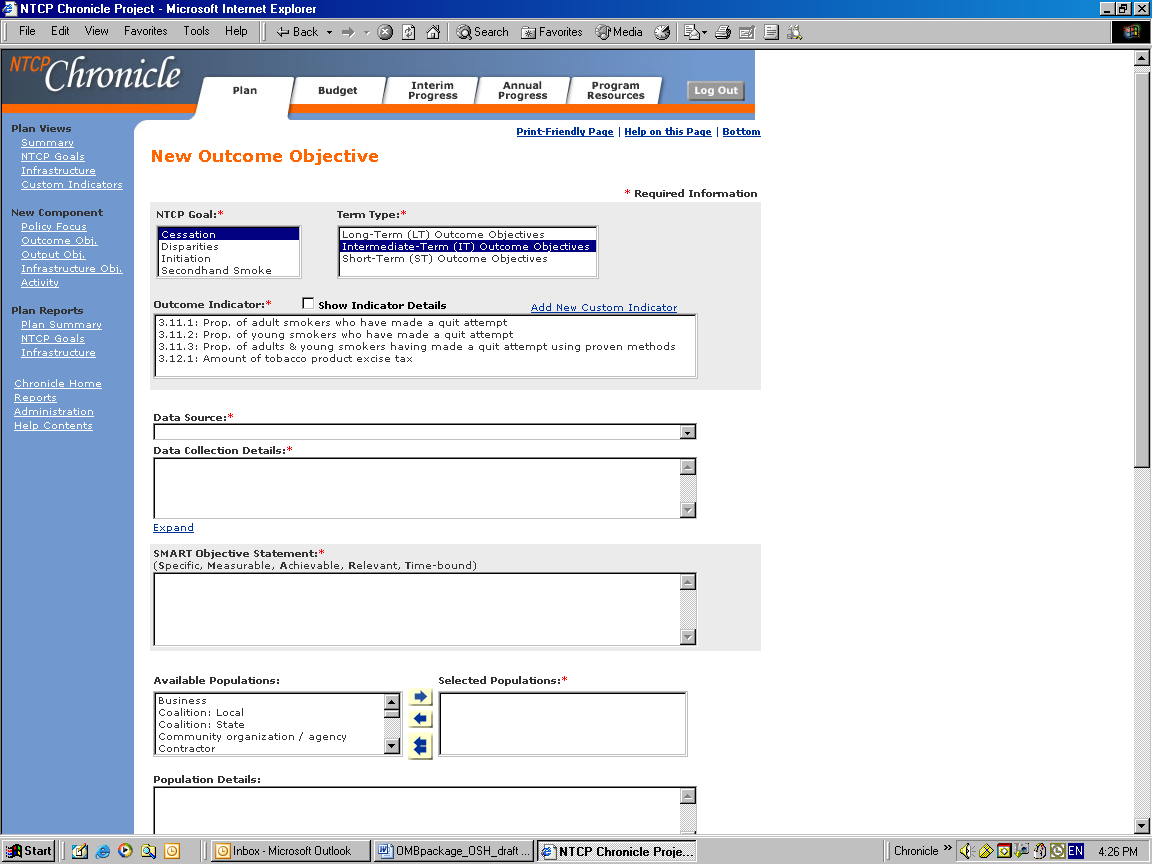
Screen shot #2: Outcome Objective Status Observation
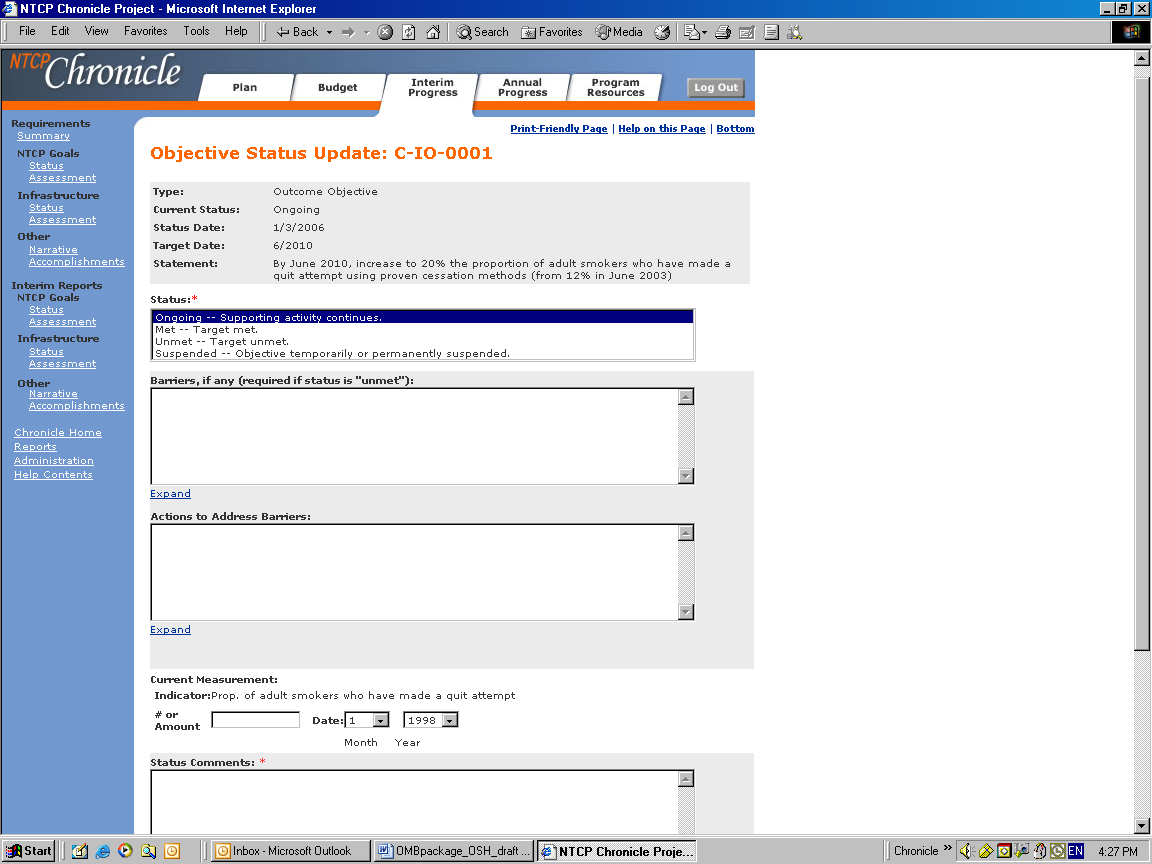
Screen shot #3: Creating an Output Objective
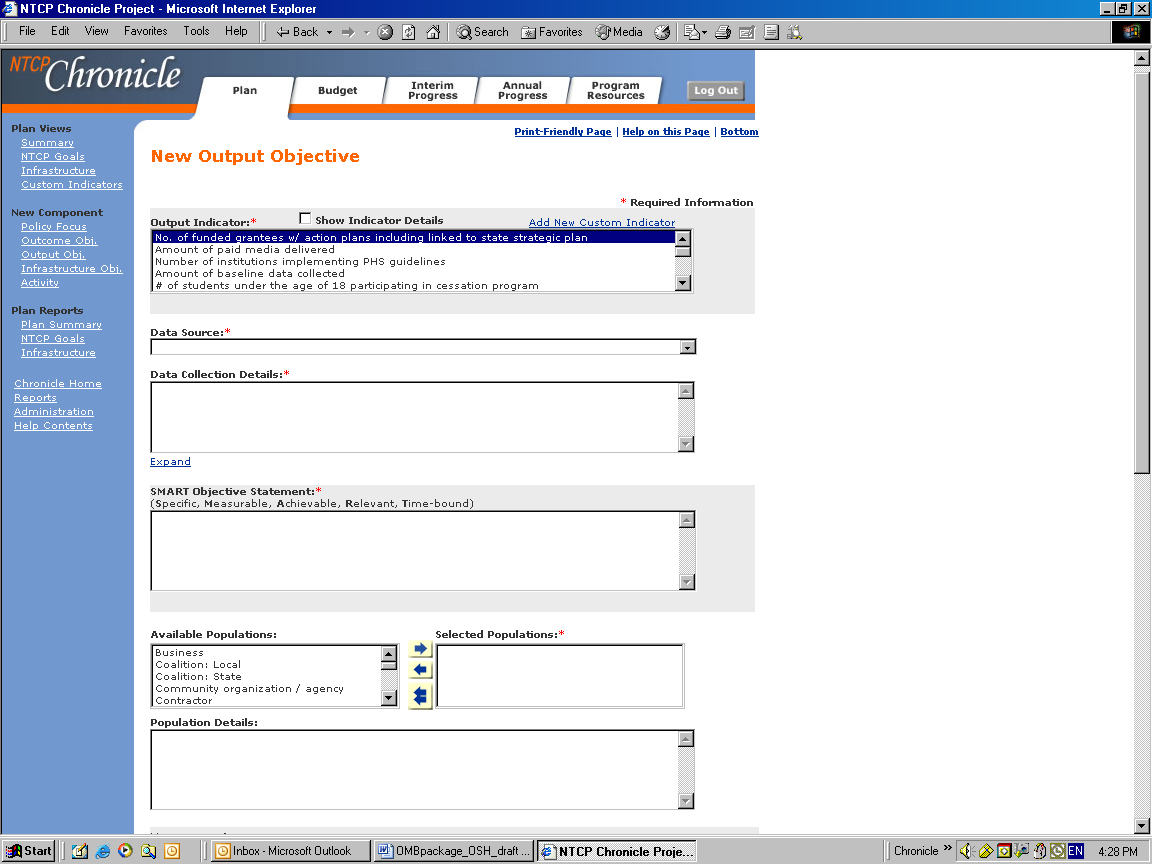
Screen shot #4: Creating a Custom Output Indicator
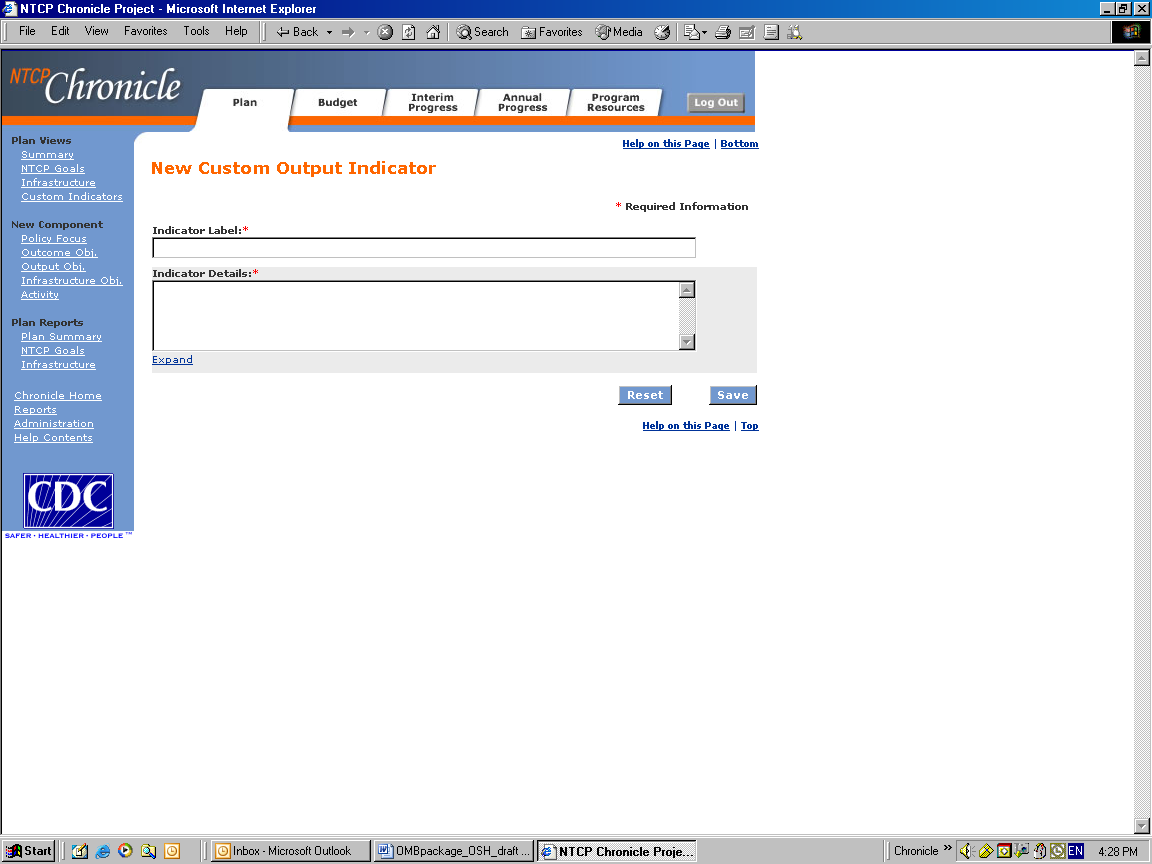
Screen shot #5: Creating an Infrastructure Objective
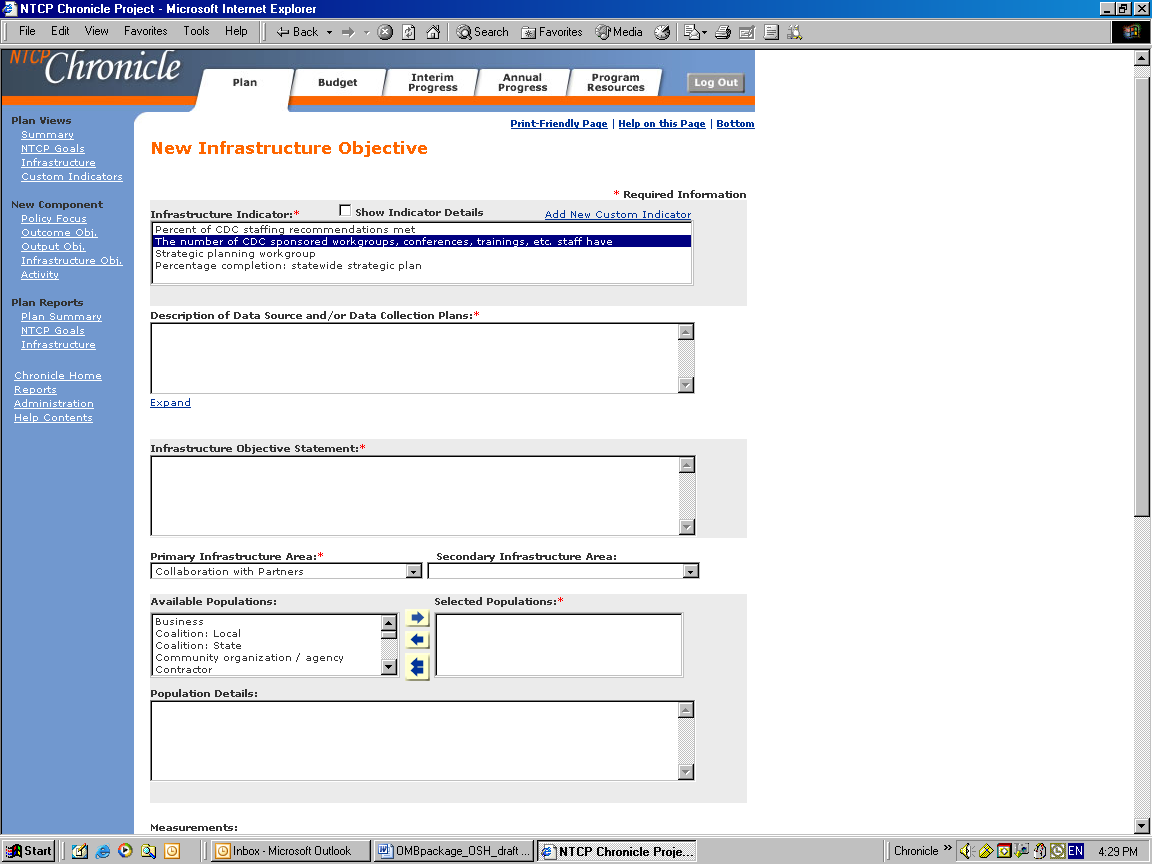
Screen shot #6: Creating a Custom Infrastructure Indicator

Screen shot #7: Process (Output) Objective Status Observation
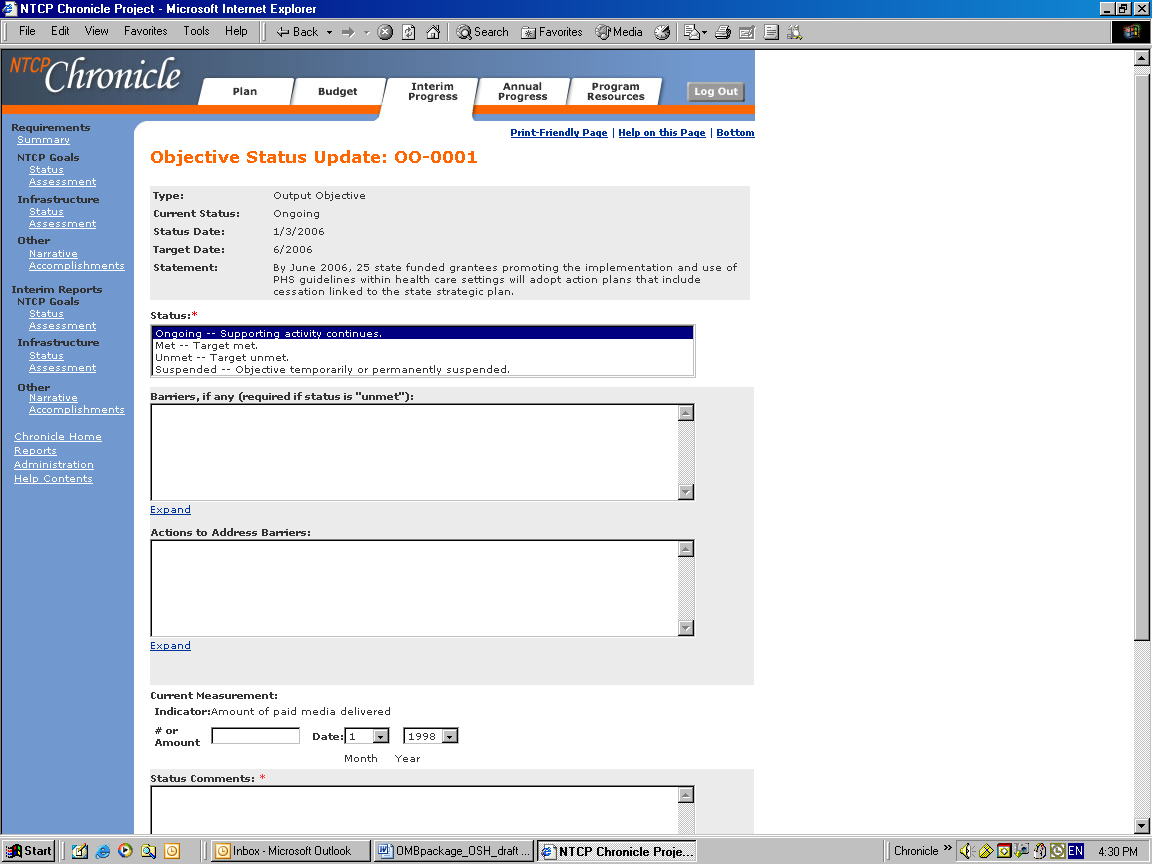
Screen shot #8: Creating an Activity
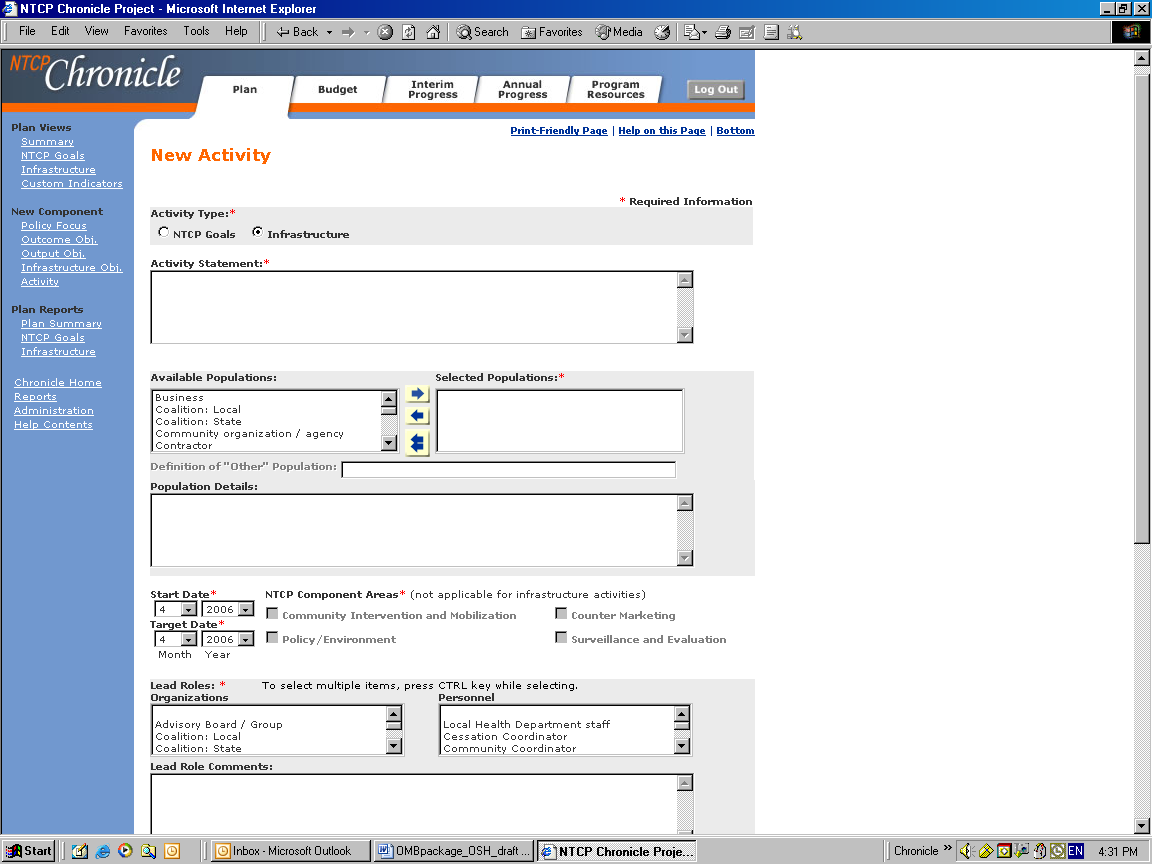
Screen shot #9: Activity Status Observation
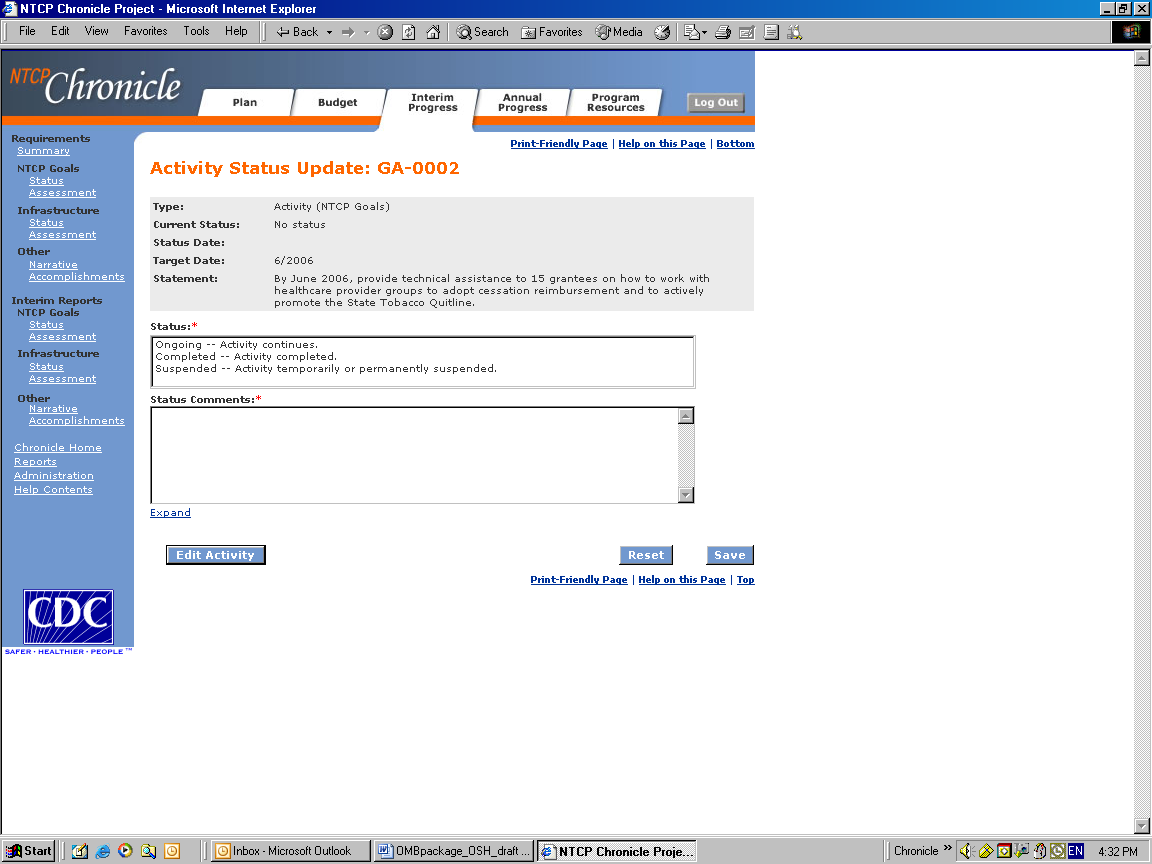
Screen shot #10: Creating a Policy Focus statement
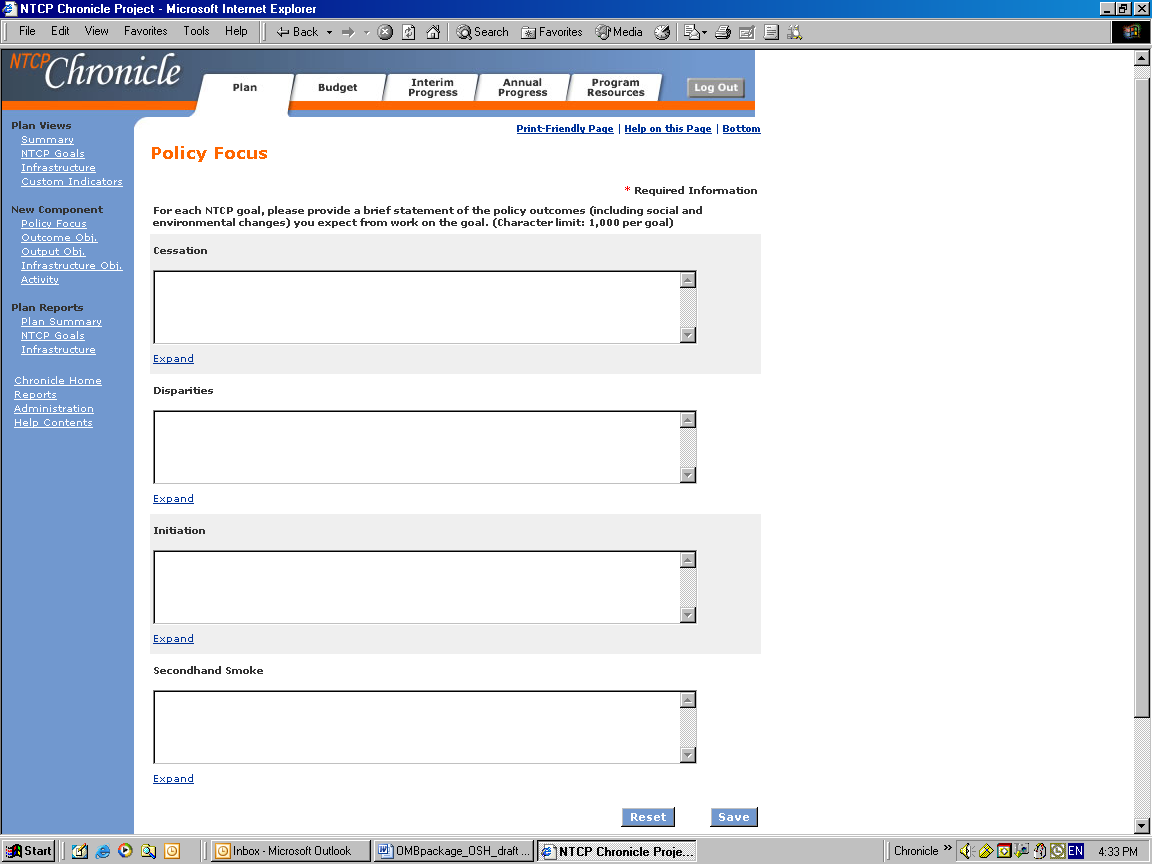
Screen shot #11: Creating Executive Summary & Program Narrative statements
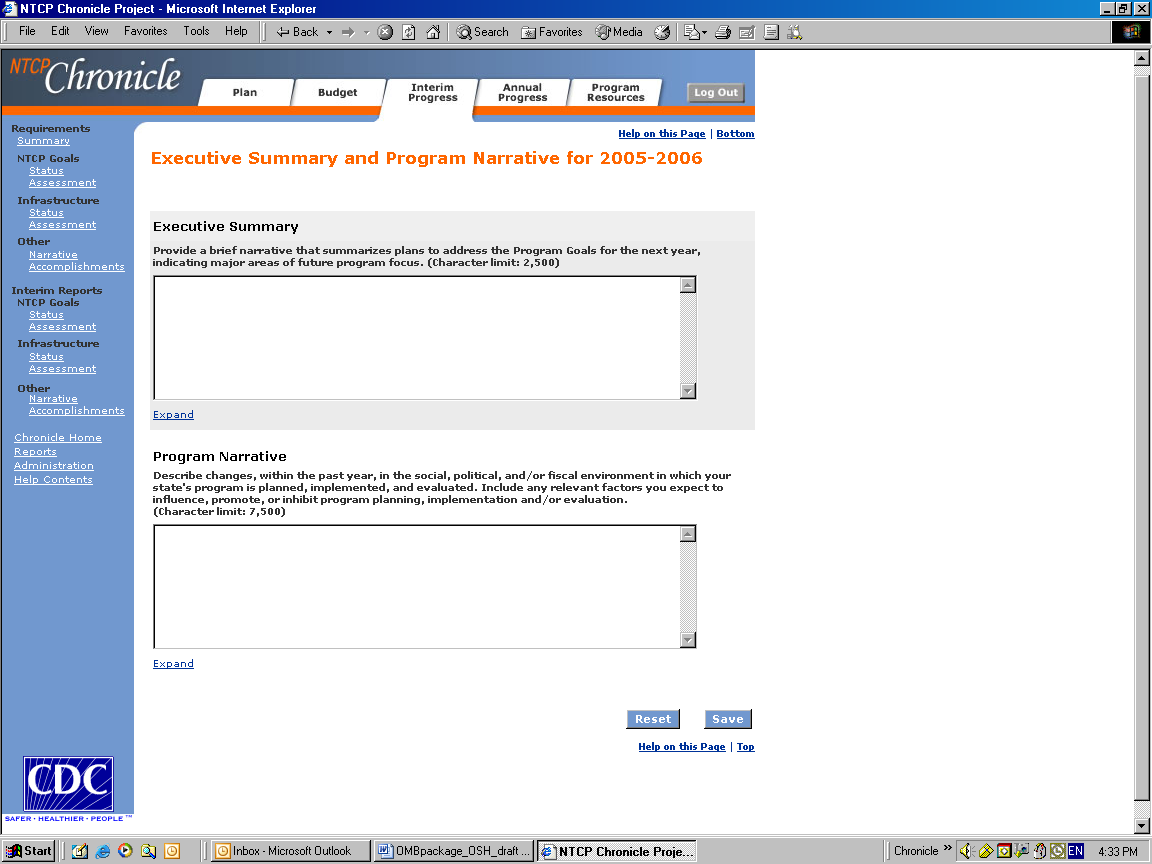
Screen shot #12: Creating Major Accomplishments & Barriers statements
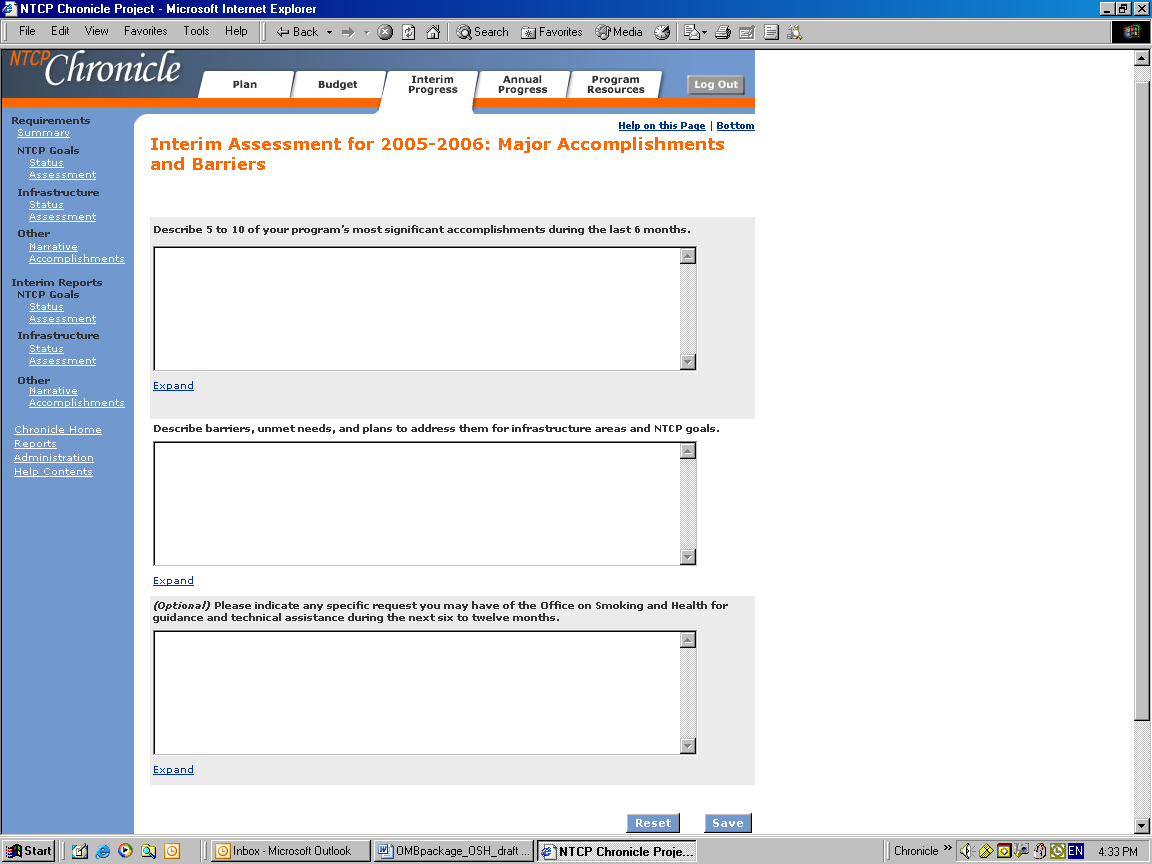
Screen shot #13: Performance Measure Assessment Question example

Screen shot #14: Performance Measure Assessment Question example
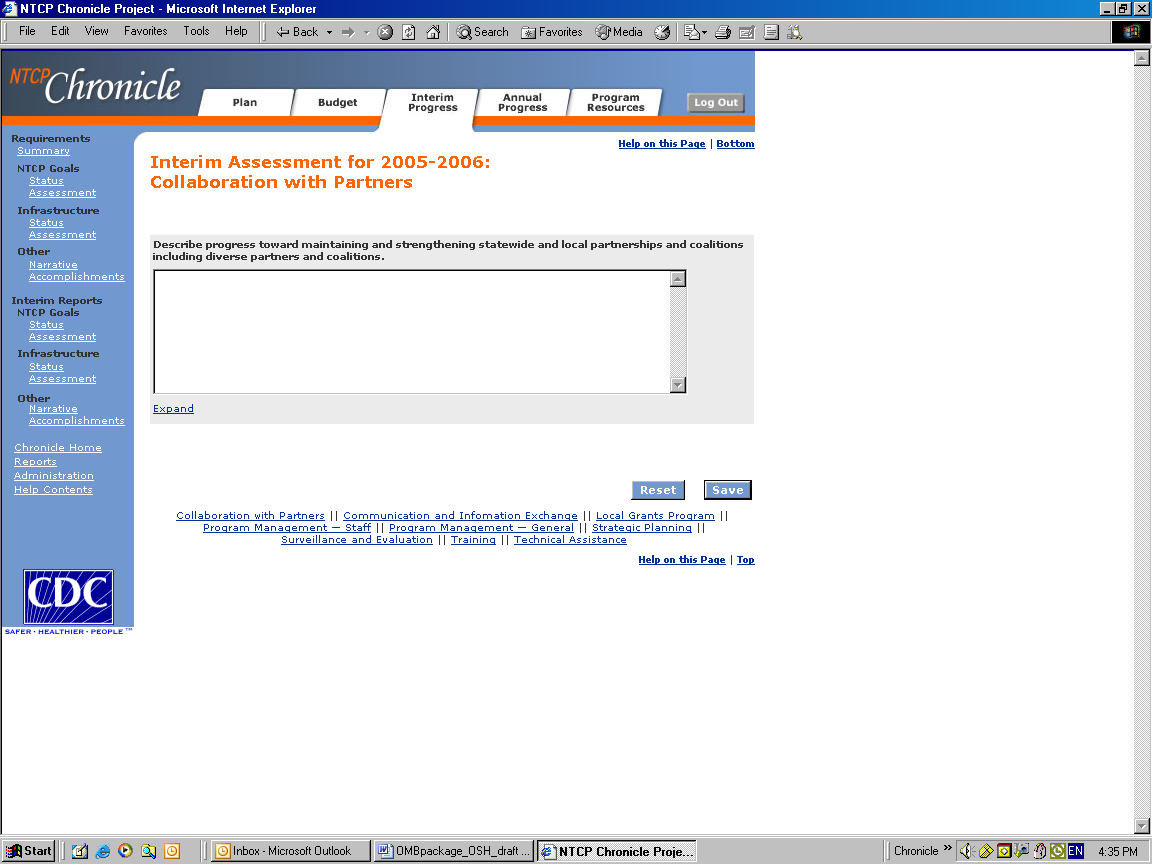
END OF SCREEN SHOTS
END OF ATTACHMENTS
Page
Centers for Disease Control and Prevention (CDC), Office on Smoking and Health (OSH)
OMB Clearance # 0920-0601, Revision
| File Type | application/msword |
| File Title | ••••••••••••••••Office of Management and Budget (OMB) |
| Author | ljp5 |
| Last Modified By | Lois P. Voelker |
| File Modified | 2007-01-23 |
| File Created | 2007-01-23 |
© 2026 OMB.report | Privacy Policy